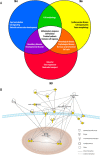Temporal gene profiling of the 5XFAD transgenic mouse model highlights the importance of microglial activation in Alzheimer's disease
- PMID: 25213090
- PMCID: PMC4237952
- DOI: 10.1186/1750-1326-9-33
Temporal gene profiling of the 5XFAD transgenic mouse model highlights the importance of microglial activation in Alzheimer's disease
Abstract
Background: The 5XFAD early onset mouse model of Alzheimer's disease (AD) is gaining momentum. Behavioral, electrophysiological and anatomical studies have identified age-dependent alterations that can be reminiscent of human AD. However, transcriptional changes during disease progression have not yet been investigated. To this end, we carried out a transcriptomic analysis on RNAs from the neocortex and the hippocampus of 5XFAD female mice at the ages of one, four, six and nine months (M1, M4, M6, M9).
Results: Our results show a clear shift in gene expression patterns between M1 and M4. At M1, 5XFAD animals exhibit region-specific variations in gene expression patterns whereas M4 to M9 mice share a larger proportion of differentially expressed genes (DEGs) that are common to both regions. Analysis of DEGs from M4 to M9 underlines the predominance of inflammatory and immune processes in this AD mouse model. The rise in inflammation, sustained by the overexpression of genes from the complement and integrin families, is accompanied by an increased expression of transcripts involved in the NADPH oxidase complex, phagocytic processes and IFN-γ related pathways.
Conclusions: Overall, our data suggest that, from M4 to M9, sustained microglial activation becomes the predominant feature and point out that both detrimental and neuroprotective mechanisms appear to be at play in this model. Furthermore, our study identifies a number of genes already known to be altered in human AD, thus confirming the use of the 5XFAD strain as a valid model for understanding AD pathogenesis and for screening potential therapeutic molecules.
Figures







Similar articles
-
Quantitative proteomics of acutely-isolated mouse microglia identifies novel immune Alzheimer's disease-related proteins.Mol Neurodegener. 2018 Jun 28;13(1):34. doi: 10.1186/s13024-018-0266-4. Mol Neurodegener. 2018. PMID: 29954413 Free PMC article.
-
Activation of the nuclear receptor PPARδ is neuroprotective in a transgenic mouse model of Alzheimer's disease through inhibition of inflammation.J Neuroinflammation. 2015 Jan 16;12:7. doi: 10.1186/s12974-014-0229-9. J Neuroinflammation. 2015. PMID: 25592770 Free PMC article.
-
Immune hyperreactivity of Aβ plaque-associated microglia in Alzheimer's disease.Neurobiol Aging. 2017 Jul;55:115-122. doi: 10.1016/j.neurobiolaging.2017.03.021. Epub 2017 Mar 27. Neurobiol Aging. 2017. PMID: 28434692
-
A core transcriptional signature of human microglia: Derivation and utility in describing region-dependent alterations associated with Alzheimer's disease.Glia. 2019 Jul;67(7):1240-1253. doi: 10.1002/glia.23572. Epub 2019 Feb 13. Glia. 2019. PMID: 30758077 Review.
-
The classification of microglial activation phenotypes on neurodegeneration and regeneration in Alzheimer's disease brain.Arch Immunol Ther Exp (Warsz). 2012 Aug;60(4):251-66. doi: 10.1007/s00005-012-0181-2. Epub 2012 Jun 19. Arch Immunol Ther Exp (Warsz). 2012. PMID: 22710659 Free PMC article. Review.
Cited by
-
Opposing roles of the triggering receptor expressed on myeloid cells 2 and triggering receptor expressed on myeloid cells-like transcript 2 in microglia activation.Neurobiol Aging. 2016 Jun;42:132-41. doi: 10.1016/j.neurobiolaging.2016.03.004. Epub 2016 Mar 16. Neurobiol Aging. 2016. PMID: 27143430 Free PMC article.
-
The regulatory mechanism and therapeutic potential of transcription factor EB in neurodegenerative diseases.CNS Neurosci Ther. 2023 Jan;29(1):37-59. doi: 10.1111/cns.13985. Epub 2022 Oct 2. CNS Neurosci Ther. 2023. PMID: 36184826 Free PMC article. Review.
-
Spatiotemporal Dysregulation of Neuron-Glia Related Genes and Pro-/Anti-Inflammatory miRNAs in the 5xFAD Mouse Model of Alzheimer's Disease.Int J Mol Sci. 2024 Aug 31;25(17):9475. doi: 10.3390/ijms25179475. Int J Mol Sci. 2024. PMID: 39273422 Free PMC article.
-
Carprofen alleviates Alzheimer-like phenotypes of 5XFAD transgenic mice by targeting the pathological hallmarks induced by amyloid-β aggregation.Sci Rep. 2023 Jul 5;13(1):10889. doi: 10.1038/s41598-023-36167-4. Sci Rep. 2023. PMID: 37407605 Free PMC article.
-
Changes in the brain transcriptome after DNA Aβ42 trimer immunization in a 3xTg-AD mouse model.Neurobiol Dis. 2021 Jan;148:105221. doi: 10.1016/j.nbd.2020.105221. Epub 2020 Dec 11. Neurobiol Dis. 2021. PMID: 33316368 Free PMC article.
References
-
- Oakley H, Cole SL, Logan S, Maus E, Shao P, Craft J, Guillozet-Bongaarts A, Ohno M, Disterhoft J, Van Eldik L, Berry R, Vassar R. Intraneuronal beta-amyloid aggregates, neurodegeneration, and neuron loss in transgenic mice with five familial Alzheimer's disease mutations: potential factors in amyloid plaque formation. J Neurosci. 2006;26:10129–10140. - PMC - PubMed
-
- Hardy J, Selkoe DJ. The amyloid hypothesis of Alzheimer's disease: progress and problems on the road to therapeutics. Science. 2002;297:353–356. - PubMed
-
- Hong S, Quintero-Monzon O, Ostaszewski BL, Podlisny DR, Cavanaugh WT, Yang T, Holtzman DM, Cirrito JR, Selkoe DJ. Dynamic analysis of amyloid beta-protein in behaving mice reveals opposing changes in ISF versus parenchymal Abeta during age-related plaque formation. J Neurosci. 2011;31:15861–15869. - PMC - PubMed
Publication types
MeSH terms
LinkOut - more resources
Full Text Sources
Other Literature Sources
Medical
Molecular Biology Databases

